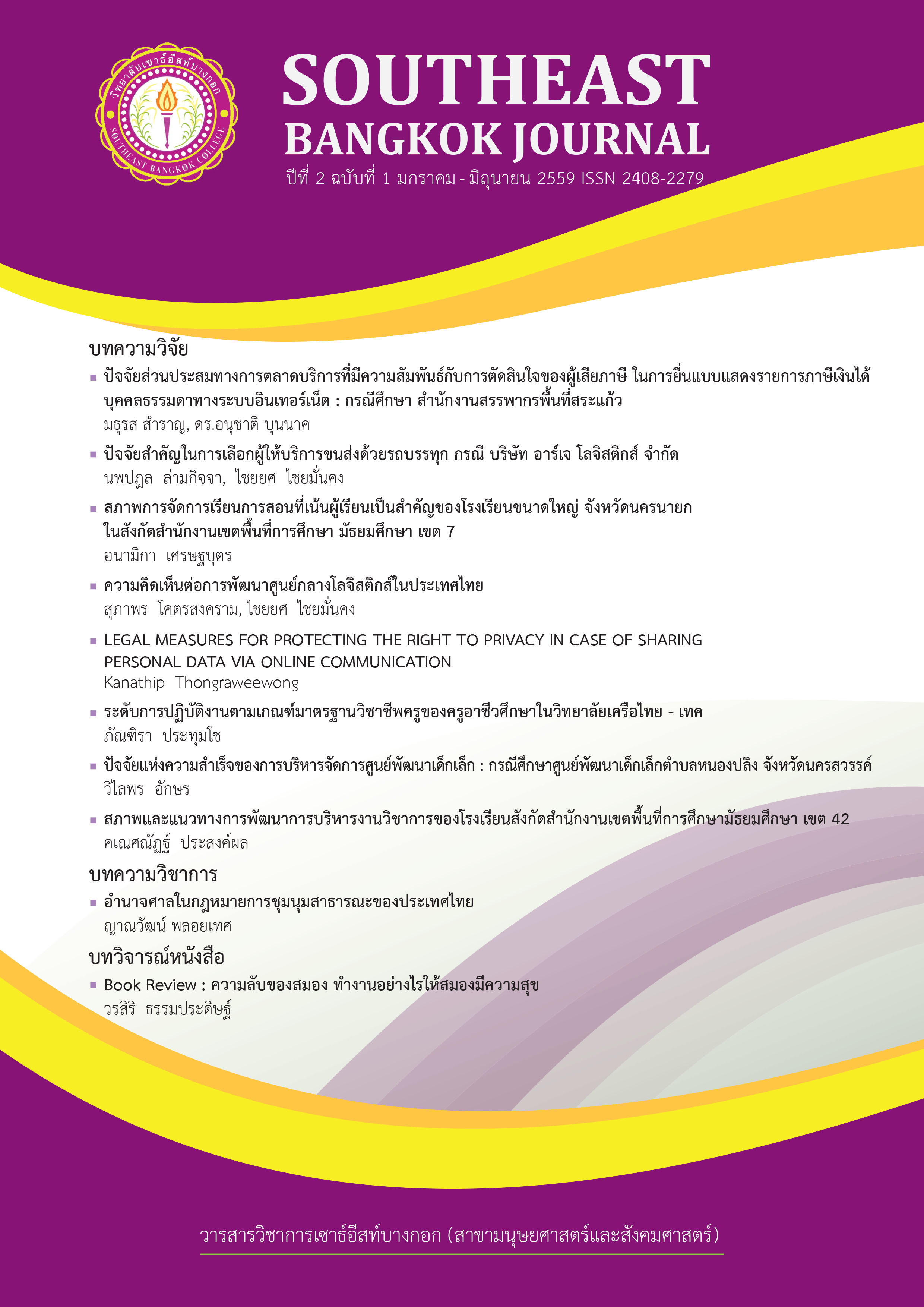LEGAL MEASURES FOR PROTECTING THE RIGHT TO PRIVACY IN CASE OF SHARING PERSONAL DATA VIA ONLINE COMMUNICATION
Main Article Content
บทคัดย่อ
ผู้ใช้งานการสื่อสารข้อมูลออนไลน์ รวมถึงการสื่อสารข้อมูลทางอินเทอร์เน็ต เว็บไซต์ เครือข่ายสังคมโปรแกรมประยุกต์เพื่อการสนทนาทางโทรศัพท์เคลื่อนที่ ได้มีการเผยแพร่ข้อมูล เกี่ยวข้องกับมิติต่าง ๆ ในชีวิตของตน ข้อมูลที่ถูกเผยแพร่นั้นรวมถึง ภาพถ่าย หมายเลขโทรศัพท์ ที่อยู่ อิเล็กทรอนิกส์ สถานที่ทํางาน เป็นต้น ซึ่งข้อมูลเหล่านี้จัดเป็น ข้อมูลส่วนบุคคล นอกจากการเผยแพร่ ข้อมูลส่วนบุคคลดังกล่าวที่กระทําขึ้นโดยผู้ใช้งานการสื่อสารออนไลน์ดังกล่าวแล้ว ผู้ที่มิได้เป็นผู้ใช้งาน การสื่อสารออนไลน์ก็อาจได้รับผลกระทบจากการถูกนําข้อมูลไปเผยแพร่ในการสื่อสารออนไลน์ด้วย งานวิจัยนี้ได้จําแนกการเผยแพร่ข้อมูลส่วนบุคคลทางการสื่อสารออกเป็นสองกรณีคือ กรณีแรก การ สื่อสารข้อมูลส่วนบุคคลของตนเอง ซึ่งอยู่บนพื้นฐานพฤติกรรมการเปิดเผยตัวตนอันเป็นที่นิยมอย่าง กว้างขวางในการสื่อสารออนไลน์ปัจจุบัน กรณีที่สอง การเผยแพร่ข้อมูลส่วนบุคคลของผู้อื่นโดยมิได้ รับความยินยอม ซึ่งส่งผลกระทบต่อสิทธิส่วนบุคคลอันเป็นสิทธิขั้นพื้นฐานที่สําคัญของมนุษย์ ดังนั้น งานวิจัยนี้จึงมุ่งศึกษาการปรับใช้มาตรการทางกฎหมายในการคุ้มครองข้อมูลส่วนบุคคลในบริบทของ การสื่อสารข้อมูลออนไลน์ ผลการวิจัยจากการวิเคราะห์ข้อมูลเชิงคุณภาพและการวิเคราะห์เนื้อหาเชิง เปรียบเทียบระหว่างกฎหมายไทยและกฎหมายต่างประเทศ ชี้ให้เห็นว่า ในปัจจุบัน ไทยยังไม่มี กฎหมายเฉพาะเกี่ยวกับการคุ้มครองสิทธิส่วนบุคคลและข้อมูลส่วนบุคคล แม้ว่าจะมีกฎหมายหลาย ฉบับที่อาจนํามาปรับใช้ในการคุ้มครองสิทธิส่วนบุคคลจากกรณีเผยแพร่ข้อมูลส่วนบุคคลในการสื่อสาร ข้อมูลออนไลน์ งานวิจัยนี้พบว่า ยังมีปัญหาในเชิงเนื้อหา องค์ประกอบ และขอบเขตหลายประการ อันทําให้กฎหมายดังกล่าวยังไม่เหมาะสมและเพียงพอในการนํามาปรับใช้เพื่อคุ้มครองสิทธิของผู้ได้รับ ผลกระทบจากการเผยแพร่ข้อมูลส่วนบุคคลในการสื่อสารออนไลน์ งานวิจัยนี้จึงได้มีข้อเสนอแนะเพื่อ ปรับปรุงแก้ไขกฎหมายอันจะนําไปสู่การลดผลกระทบจากการเผยแพร่ข้อมูลและการคุ้มครองสิทธิ ส่วนบุคคลอย่างเหมาะสม
Article Details
เอกสารอ้างอิง
Barker, K. J., D'Amato, J., & Sheridon, P. (2008). Credit card fraud: awareness and prevention. Journal of Financial Crime, 15(4), 398-410.
Benton, M., Blair, K., Crowe, M. & Schuh, S. (2007). The Boston Fed study of consumer behavior and payment choice: a survey of Federal Reserve System employees. Retrieved May 7, 2015, from http://www.bostonfed.org/economic/ppdp/2007/ppdp0701.htm
Birkinshaw, Patrick. (2001). Freedom of Information : The law, the practice and the Ideal. US: Butterworths.
Caudill, Edward. (1992, December). E. L. Godkin and his view of 19th century journalism. Journalism & Mass Communication Quarterly, 1039–1049.
Conkey, C. (2007). Assessing Identity-Theft Costs. The Wall Street Journal - Eastern Edition, (250), 3.
Culnan, M. J. & Armstrong, P. (1999). Information privacy concerns, procedural fairness, and impersonal trust. An empirical investigation, Organization Science, 10(1),
104-115.
Donnelly, Jack. (1982, June). Human Rights and Human Dignity: An Analytic Critique of Non-Western Conceptions of Human Rights. American Political Science
Review, (76), 303-316.
Gavison, Ruth. (1980, January). Privacy and the Limits of law. The Yale Law Journal, 89(3), 421-471.
Gutwirth, S. (2002). Privacy and the Information Age. Oxford, UK: Rowman & Littlefield. Haag, Van Den, Ernest. (1971). On Privacy. In J. Pennock & J. Chapman (Eds.), Nomos XIII: Privacy. (pp.149-168). New York: Atherton Press.
Hendricks E, Hayden T & J. D. Novik. (1990). Your right to Privacy: A Basic Guide to Legal Rights in an information Societ. US: Southern Illinois University Press.
Homans, G. C. (1958, May). Social Behavior as Exchange. American Journal of Sociology, 63, 597-606.
Joinson, A. N. & Paine, C. B. (2007). Self-Disclosure, Privacy and the Internet, Oxford handbook of internet psychology. Oxford, UK: OUP.
Jonker, N. (2007). Payment instruments as perceived by consumers - Results from a household survey. De Economist, 155(3), Retrieved May 14, 2015, from
http://www.dnb.nl/binaries/Working%20Paper%2053_tcm 46-146710.pdf
Kanathip Thongraweewong. (2012, May). Legal Measures for protecting the right to privacy: A study of invasion of privacy through the use of social network
websites. APHEIT Journal, 18(1), 39-51.
Kanathip, Thongraweewong. (2014). State Telecommunication Surveillance: A Comparative Study of the US and Thai Telecommunication Privacy Laws, Conference Proceedings of the Forth International Conference on Digital Information and Communication Technology and its applications. Retrieved June 16, 2015, from
http://ieeexplore.ieee.org/xpl/articleDetails.jsp?arnumber=6821709
Listerman RA, Romesberg J. (2009). Are We Safe Yet?. Strategic Finance, 91(1), 27-33.
Organization for Economic Cooperation and Development. (2008). OECD Policy Guidance on Online Identity theft. Retrieved May 15, 2015, from http://www.oecd.org/dataoecd/49/39/40879136.pdf
Posner, Richard. (1998). Economic analysis of law, (fifth edition). U.S. : Aspen Law & Business.
Prosser, William. (1960, August). Privacy. California Law Review, 48(3), 383-423.
Rosen, P. & Sherman, P. (2006). Hedonic Information Systems: Acceptance of Social Networking Websites, in Americas Conference on Information Systems, Mexico:
Acapulco.
Solove, Daniel J. (2003, Fall/Winter). Identity Theft, Privacy, and the Architecture of Vulnerability. Hastings Law Journal, 1227-1275.
Spiekermann, Sarah, Krasnova, Hanna, Koroleva, Ksenia & Hildebrand, Thomas. (2010). Online Social Networks: Why We Disclose. Journal of Information Technology,
25(2), 109-125.
Sproule S, Archer N. (2010, November). Measuring identity theft and identity fraud. International Journal of Business Governance and Ethics, 5, 51-63.


